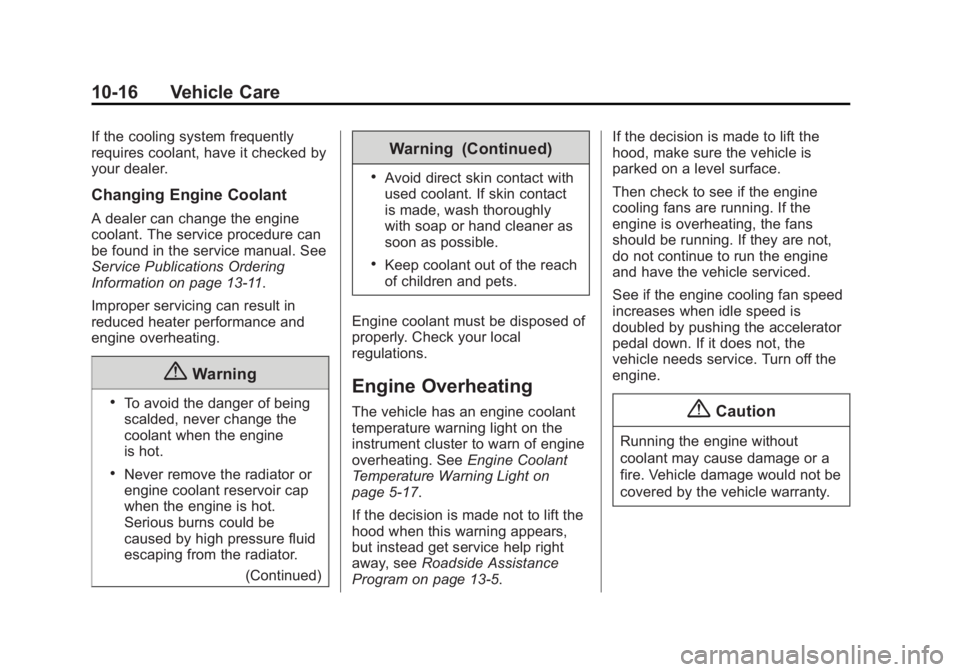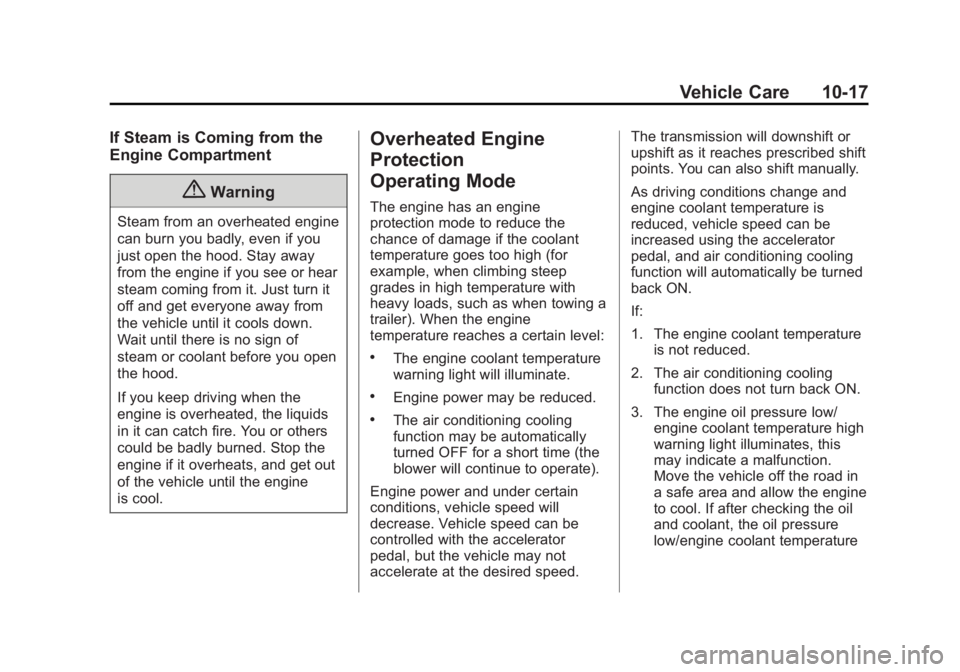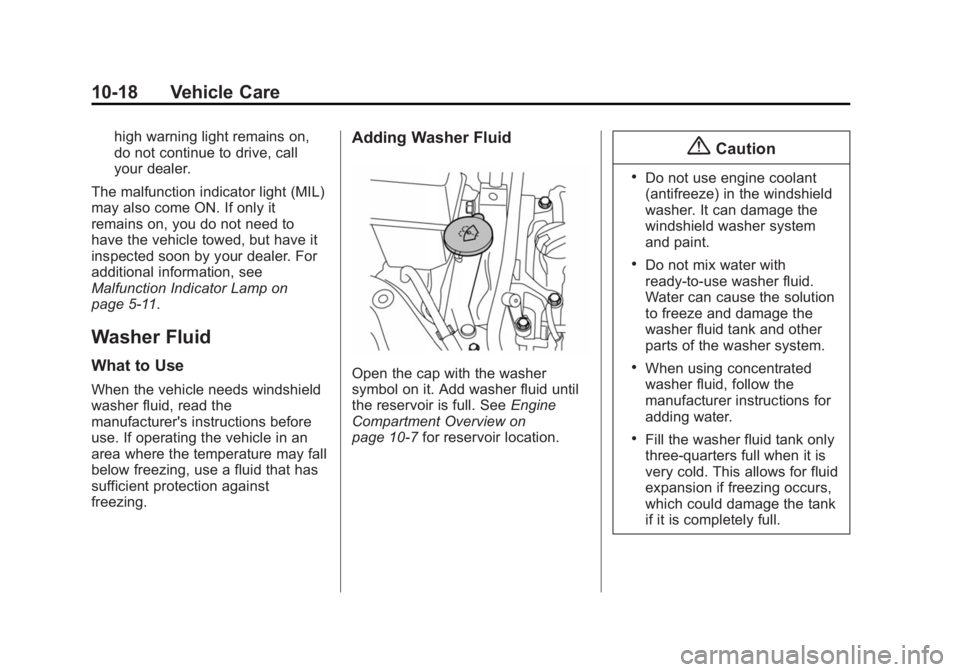2016 CHEVROLET CITY EXPRESS warning light
[x] Cancel search: warning lightPage 181 of 297

Black plate (40,1)Chevrolet City Express Owner Manual (GMNA-Localizing-U.S./Canada-
7707496) - 2015 - CRC - 11/26/14
9-40 Driving and Operating Be careful not to spill fuel. Do not
top off or overfill the tank and wait a
few seconds after you have finished
pumping before removing the
nozzle. Clean fuel from painted
surfaces as soon as possible. See
Exterior Care on page 10-61 .
When replacing the fuel cap, turn it
clockwise until it clicks. Make sure
the cap is fully installed.
{ WarningIf a fire starts while you are
refueling, do not remove the
nozzle. Shut off the flow of fuel by
shutting off the pump or by
notifying the station attendant.
Leave the area immediately. { CautionIf a new fuel cap is needed, be
sure to get the right type of cap
from your dealer. The wrong type
of fuel cap may not fit properly,
may cause the malfunction
indicator lamp to light, and could
damage the fuel tank and
emissions system. See
Malfunction Indicator Lamp on
page 5-11 .
LOOSE FUEL CAP Warning
Message
The LOOSE FUEL CAP message
displays in the odometer when the
fuel cap is not tightened correctly
after the vehicle has been refueled.
See Fuel System Messages on
page 5-20 .
Failure to tighten the fuel cap
properly after the LOOSE FUEL
CAP warning message is displayed
may cause the malfunction indicator light (MIL) to turn on. See
Malfunction Indicator Lamp on
page 5-11 .
Filling a Portable Fuel
Container
{ WarningFilling a portable fuel container
while it is in the vehicle can cause
fuel vapors that can ignite either
by static electricity or other
means. You or others could be
badly burned and the vehicle
could be damaged. Always: .
Use approved fuel
containers. .
Remove the container from
the vehicle, trunk, or pickup
bed before filling. .
Place the container on the
ground.
(Continued)
Page 182 of 297

Black plate (41,1)Chevrolet City Express Owner Manual (GMNA-Localizing-U.S./Canada-
7707496) - 2015 - CRC - 11/26/14
Driving and Operating 9-41Warning (Continued) .
Place the nozzle inside the fill
opening of the container
before dispensing fuel, and
keep it in contact with the fill
opening until filling is
complete. .
Fill the container no more
than 95% full to allow for
expansion. .
Do not smoke, light matches,
or use lighters while
pumping fuel. .
Avoid using cell phones or
other electronic devices. Trailer Towing General Towing
Information The vehicle is neither designed nor
intended to tow a trailer.
Conversions and
Add-Ons Add-On Electrical
Equipment
{ CautionSome electrical equipment can
damage the vehicle or cause
components to not work and
would not be covered by the
warranty. Always check with your
dealer before adding electrical
equipment.
Add-on equipment can drain the
vehicle's 12-volt battery, even if the
vehicle is not operating.
The vehicle has an airbag system.
Before attempting to add anything
electrical to the vehicle, see
Servicing the Airbag-Equipped
Vehicle on page 3-28 and Adding
Equipment to the Airbag-Equipped
Vehicle on page 3-29 .
Page 199 of 297

Black plate (16,1)Chevrolet City Express Owner Manual (GMNA-Localizing-U.S./Canada-
7707496) - 2015 - CRC - 11/26/14
10-16 Vehicle Care If the cooling system frequently
requires coolant, have it checked by
your dealer.
Changing Engine Coolant A dealer can change the engine
coolant. The service procedure can
be found in the service manual. See
Service Publications Ordering
Information on page 13-11 .
Improper servicing can result in
reduced heater performance and
engine overheating.
{ Warning.
To avoid the danger of being
scalded, never change the
coolant when the engine
is hot. .
Never remove the radiator or
engine coolant reservoir cap
when the engine is hot.
Serious burns could be
caused by high pressure fluid
escaping from the radiator.
(Continued) Warning (Continued) .
Avoid direct skin contact with
used coolant. If skin contact
is made, wash thoroughly
with soap or hand cleaner as
soon as possible. .
Keep coolant out of the reach
of children and pets.
Engine coolant must be disposed of
properly. Check your local
regulations.
Engine Overheating The vehicle has an engine coolant
temperature warning light on the
instrument cluster to warn of engine
overheating. See Engine Coolant
Temperature Warning Light on
page 5-17 .
If the decision is made not to lift the
hood when this warning appears,
but instead get service help right
away, see Roadside Assistance
Program on page 13-5 . If the decision is made to lift the
hood, make sure the vehicle is
parked on a level surface.
Then check to see if the engine
cooling fans are running. If the
engine is overheating, the fans
should be running. If they are not,
do not continue to run the engine
and have the vehicle serviced.
See if the engine cooling fan speed
increases when idle speed is
doubled by pushing the accelerator
pedal down. If it does not, the
vehicle needs service. Turn off the
engine.
{ Caution
Running the engine without
coolant may cause damage or a
fire. Vehicle damage would not be
covered by the vehicle warranty.
Page 200 of 297

Black plate (17,1)Chevrolet City Express Owner Manual (GMNA-Localizing-U.S./Canada-
7707496) - 2015 - CRC - 11/26/14
Vehicle Care 10-17If Steam is Coming from the
Engine Compartment
{ WarningSteam from an overheated engine
can burn you badly, even if you
just open the hood. Stay away
from the engine if you see or hear
steam coming from it. Just turn it
off and get everyone away from
the vehicle until it cools down.
Wait until there is no sign of
steam or coolant before you open
the hood.
If you keep driving when the
engine is overheated, the liquids
in it can catch fire. You or others
could be badly burned. Stop the
engine if it overheats, and get out
of the vehicle until the engine
is cool. Overheated Engine
Protection
Operating Mode The engine has an engine
protection mode to reduce the
chance of damage if the coolant
temperature goes too high (for
example, when climbing steep
grades in high temperature with
heavy loads, such as when towing a
trailer). When the engine
temperature reaches a certain level: .
The engine coolant temperature
warning light will illuminate. .
Engine power may be reduced. .
The air conditioning cooling
function may be automatically
turned OFF for a short time (the
blower will continue to operate).
Engine power and under certain
conditions, vehicle speed will
decrease. Vehicle speed can be
controlled with the accelerator
pedal, but the vehicle may not
accelerate at the desired speed. The transmission will downshift or
upshift as it reaches prescribed shift
points. You can also shift manually.
As driving conditions change and
engine coolant temperature is
reduced, vehicle speed can be
increased using the accelerator
pedal, and air conditioning cooling
function will automatically be turned
back ON.
If:
1. The engine coolant temperature
is not reduced.
2. The air conditioning cooling
function does not turn back ON.
3. The engine oil pressure low/
engine coolant temperature high
warning light illuminates, this
may indicate a malfunction.
Move the vehicle off the road in
a safe area and allow the engine
to cool. If after checking the oil
and coolant, the oil pressure
low/engine coolant temperature
Page 201 of 297

Black plate (18,1)Chevrolet City Express Owner Manual (GMNA-Localizing-U.S./Canada-
7707496) - 2015 - CRC - 11/26/14
10-18 Vehicle Care high warning light remains on,
do not continue to drive, call
your dealer.
The malfunction indicator light (MIL)
may also come ON. If only it
remains on, you do not need to
have the vehicle towed, but have it
inspected soon by your dealer. For
additional information, see
Malfunction Indicator Lamp on
page 5-11 .
Washer Fluid What to Use When the vehicle needs windshield
washer fluid, read the
manufacturer's instructions before
use. If operating the vehicle in an
area where the temperature may fall
below freezing, use a fluid that has
sufficient protection against
freezing. Adding Washer Fluid
Open the cap with the washer
symbol on it. Add washer fluid until
the reservoir is full. See Engine
Compartment Overview on
page 10-7 for reservoir location.{ Caution .
Do not use engine coolant
(antifreeze) in the windshield
washer. It can damage the
windshield washer system
and paint. .
Do not mix water with
ready-to-use washer fluid.
Water can cause the solution
to freeze and damage the
washer fluid tank and other
parts of the washer system. .
When using concentrated
washer fluid, follow the
manufacturer instructions for
adding water. .
Fill the washer fluid tank only
three-quarters full when it is
very cold. This allows for fluid
expansion if freezing occurs,
which could damage the tank
if it is completely full.
Page 202 of 297

Black plate (19,1)Chevrolet City Express Owner Manual (GMNA-Localizing-U.S./Canada-
7707496) - 2015 - CRC - 11/26/14
Vehicle Care 10-19
Brakes Disc brake pads have built-in wear
indicators that make a high-pitched
warning sound when the brake pads
are worn and new pads are needed.
The sound can come and go or be
heard all the time when the vehicle
is moving, except when applying the
brake pedal firmly.
{ WarningThe brake wear warning sound
means that soon the brakes will
not work well. That could lead to
a crash. When the brake wear
warning sound is heard, have the
vehicle serviced.
{ Caution
Continuing to drive with worn-out
brake pads could result in costly
brake repair. Some driving conditions or climates
can cause a brake squeal when the
brakes are first applied or lightly
applied. This does not mean
something is wrong with the brakes.
Properly torqued wheel nuts are
necessary to help prevent brake
pulsation. When tires are rotated,
inspect brake pads for wear and
evenly tighten wheel nuts in the
proper sequence to torque
specifications. See Capacities and
Specifications on page 12-2 .
Brake pads should be replaced as
complete sets.
Brake Pedal Travel See your dealer if the brake pedal
does not return to normal height,
or if there is a rapid increase in
pedal travel. This could be a sign
that brake service may be required.
Replacing Brake System Parts
Always replace brake system parts
with new, approved replacement
parts. If this is not done, the brakes
may not work properly. The braking performance expected can change
in many other ways if the wrong
replacement brake parts are
installed or parts are improperly
installed.
Brake Fluid
The brake master cylinder reservoir
is filled with DOT 3 brake fluid. See
Engine Compartment Overview on
page 10-7 for the location of the
reservoir.
There are only two reasons why the
brake fluid level in the reservoir
might go down: .
The brake fluid level goes down
because of normal brake lining
wear. When new linings are
installed, the fluid level goes
back up.
Page 203 of 297

Black plate (20,1)Chevrolet City Express Owner Manual (GMNA-Localizing-U.S./Canada-
7707496) - 2015 - CRC - 11/26/14
10-20 Vehicle Care .
A fluid leak in the brake
hydraulic system can also cause
a low fluid level. Have the brake
hydraulic system fixed, since a
leak means that sooner or later
the brakes will not work well.
Do not top off the brake fluid.
Adding fluid does not correct a leak.
If fluid is added when the linings are
worn, there will be too much fluid
when new brake linings are
installed. Add or remove brake fluid,
as necessary, only when work is
done on the brake hydraulic system.
{ Warning
If too much brake fluid is added, it
can spill on the engine and burn,
if the engine is hot enough. You
or others could be burned, and
the vehicle could be damaged.
Add brake fluid only when work is
done on the brake hydraulic
system. See “ Checking Brake
Fluid ” in this section. Refer to the Maintenance Schedule
to determine when to check the
brake fluid. See Maintenance
Schedule on page 11-3 .
Checking Brake Fluid Check brake fluid by looking at the
brake fluid reservoir. See Engine
Compartment Overview on
page 10-7 .
The fluid level should be above
MIN. If it is not, have the brake
hydraulic system checked to see if
there is a leak. After work is done on the brake
hydraulic system, make sure the
level is above the MIN but not over
the MAX mark.
If the brake fluid is below the MIN
line, the brake warning light will
illuminate. Add brake fluid up to the
MAX line.
What to Add
Use only new DOT 3 brake fluid
from a sealed container. See
Recommended Fluids and
Lubricants on page 11-11 .
Always clean the brake fluid
reservoir cap and the area around
the cap before removing it. This
helps keep dirt from entering the
reservoir.
{ Warning
With the wrong kind of fluid in the
brake hydraulic system, the
brakes might not work well. This
could cause a crash. Always use
the proper brake fluid.
Page 220 of 297

Black plate (37,1)Chevrolet City Express Owner Manual (GMNA-Localizing-U.S./Canada-
7707496) - 2015 - CRC - 11/26/14
Vehicle Care 10-37The TPMS malfunction indicator is
combined with the low tire pressure
telltale. When the system detects a
malfunction, the telltale will flash for
approximately one minute and then
remain continuously illuminated.
This sequence will continue upon
subsequent vehicle start-ups as
long as the malfunction exists.
When the malfunction indicator is
illuminated, the system may not be
able to detect or signal low tire
pressure as intended. TPMS
malfunctions may occur for a variety
of reasons, including the installation
of replacement or alternate tires or
wheels on the vehicle that prevent
the TPMS from functioning properly.
Always check the TPMS malfunction
telltale after replacing one or more
tires or wheels on your vehicle to
ensure that the replacement or
alternate tires and wheels allow the
TPMS to continue to function
properly.
See Tire Pressure Monitor
Operation on page 10-37 . See Radio Frequency Statement on
page 13-12 .
Tire Pressure Monitor
Operation This vehicle may have a Tire
Pressure Monitor System (TPMS).
The TPMS is designed to warn the
driver when a low tire pressure
condition exists. TPMS sensors are
mounted onto each tire and wheel
assembly, excluding the spare tire
and wheel assembly. The TPMS
sensors monitor the air pressure in
the tires and transmit the tire
pressure readings to a receiver
located in the vehicle.
When a low tire pressure condition
is detected, the TPMS illuminates
the low tire pressure warning light located on the instrument cluster.
If the warning light comes on, stop
as soon as possible and inflate the
tires to the recommended pressure
shown on the Tire and Loading
Information label. See Vehicle Load
Limits on page 9-9 .
A message displays when the low
tire pressure warning light comes on
and low tire pressure is detected.
See Tire Messages on page 5-20 .
The message and low tire pressure
warning light come on at each
ignition cycle until the tires are
inflated to the correct inflation
pressure. The vehicle must be
driven at speeds above 25 km/h
(16 mph) to activate the TPMS and
turn off the low tire pressure
warning light.
The low tire pressure warning light
may come on in cool weather when
the vehicle is first started, and then
turn off as the vehicle is driven. This
could be an early indicator that the